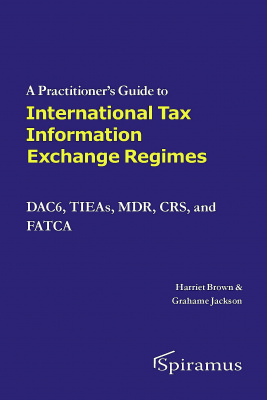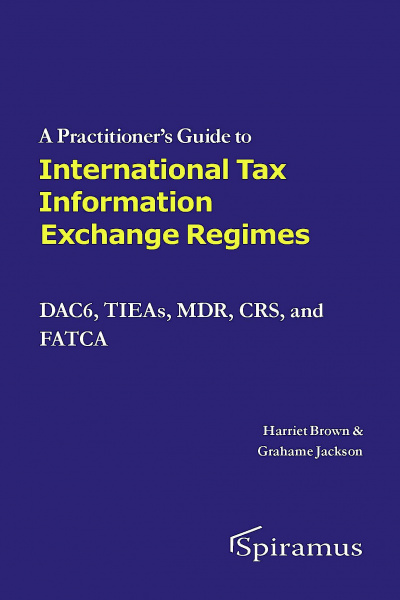A Practitioner's Guide To International Tax Information Exchange Regimes
DAC6, TIEAs, MDR, CRS, and FATCA
The sixth amendment to the Directive on Administrative Cooperation in the field of taxation (DAC6) and mandatory disclosure regimes (MDRs) in many jurisdictions have led to a large number of professionals potentially being required to disclose information in relation to their clients’ arrangements. The authors analyse the operation of the various automatic exchange of information regimes introduced in the last five years, including the OECD common reporting standards, DAC6 and MDRs, setting them in their historical context. They focus on the guidance offered by the Irish and UK tax authorities with reference to other guidance in Europe and beyond, where appropriate.
- AvailablePaperback9781913507237414 pagesList Price: GBP 99.95 Add to basket
- AvailablePDF9781913507244414 pagesList Price: GBP 49.98 Add to basket
The sixth amendment to the Directive on Administrative Cooperation in the field of taxation (DAC6) and mandatory disclosure regimes (MDRs) in many jurisdictions have led to a large number of professionals potentially being required to disclose information in relation to their clients’ arrangements.
The authors analyse the operation of the various automatic exchange of information regimes introduced in the last five years, including the OECD common reporting standards, DAC6 and MDRs, setting them in their historical context. They focus on the guidance offered by the Irish and UK tax authorities with reference to other guidance in Europe and beyond, where appropriate.
Contents .................................................................................iii
Acknowledgements ...................................................................viii
Guidance Abbreviations .............................................................ix
Introduction .............................................................................xi
1. History and Context........................................................... 1
1.1 The historical landscape in relation to tax information exchange 1
1.2 International relations and the family of nations: first attempts 2
1.3 After the war – lost opportunities 5
1.4 Global economic crisis – a reawakening of awareness 7
1.5 Tax information exchange agreements 10
1.6 FATCA, CRS and real automatic exchange 13
1.7 Base Erosion & Profit Shifting – the bandwagon rolls on 15
1.8 EU Implementation of Action Point 12 17
1.9 Mandatory Disclosure Regime (MDR) 18
1.10 Conclusion 19
2 Types of Exchange ..............................................................21
2.1 Spontaneous exchange of information 22
2.2 Automatic exchange of information (‘AEOI’) 24
2.3 Exchange of information on request 25
2.4 Current examples of information exchange 27
2.4.1 Double taxation treaties 27
2.4.2 Tax Information Exchange Agreements (TIEAS) 28
2.4.3 CRS and FATCA 28
2.4.4 Mandatory disclosure regime (“MDR”) 29
2.4.5 EU DAC6 30
2.4.6 Country by country reporting 31
3 Interpretation .....................................................................32
3.1 Introductory principles 32
3.1.1 Rules of interpretation: introduction 32
3.2 National provisions 33
3.2.1 Context of interpretation 33
3.2.2 Starting point 34
3.2.3 Uncertainty 35
3.3 International provisions: other than EU provisions 35
3.4 Interpretation of EU provisions 40
3.4.1 The treaties 40
3.4.2 Regulations 41
3.4.3 Directives 41
3.4.4 Conflicts between EU and domestic law 42
3.5 Guidance generally 43
4 Disclosure of Tax Avoidance Schemes (‘DOTAS’) ................44
4.1 An introduction 44
4.2 Scope 44
4.3 What arrangements need reporting? 45
4.4 Who reports? 45
4.4.1 Designing Schemes 46
4.4.2 Making Schemes available for implementation 47
4.4.3 Making a firm approach to another 47
4.4.4 Introducers 48
4.5 Hallmarks 49
4.5.1 Hallmark 1 ‘Confidentiality’ 50
4.5.2 Hallmark 2 ‘Confidentiality with no promoter’ 50
4.5.3 Hallmark 3 – Premium fee 51
4.5.4 Hallmark 5 – Standardised tax products 53
4.5.5 Hallmark 6 Loss schemes 56
4.5.6 Hallmark 7 Leasing arrangements 57
4.5.7 Hallmark 8 Employment income provided through third parties 59
4.5.8 Hallmark 9 Financial products 61
4.6 Conclusion 63
5 Foreign Account Tax Compliance Act - FATCA.......................65
5.1 FATCA and other regimes 65
5.2 FATCA, MDR and DAC6 65
5.3 What is FATCA? 66
5.4 Purpose 68
5.5 Implementation: introduction 69
5.6 Model 1 IGAs: Introduction 69
5.7 Terminology: introduction 70
5.8 Terminology: Financial Institutions 71
5.9 NFFE 108
5.10 Financial accounts 109
5.11 Financial assets 114
5.12 Obligations (other than reporting) under FATCA 115
5.13 Identification of preexisting accounts: individual accounts 116
5.14 Identification of preexisting accounts: preexisting entity accounts 125
5.15 Obligations in relation to new accounts: new individual accounts 130
5.16 Obligations in relation to new accounts: new entity accounts 132
5.17 Reporting under a Model 1A IGA 134
5.18 Model 1A IGA: withholding and penalties 139
5.19 Model 1B IGA: differences 142
5.20 Model 2: differences 145
5.21 No IGA and withholding 151
6 CRS .....................................................................................152
6.1 What is CRS? 152
6.2 A (brief) background 153
6.3 Purpose 154
6.4 CRS and other regimes 155
6.5 Scope and comparison with FATCA 159
6.6 Implementation: introduction 162
6.7 Implementation: competent authority agreements 166
6.8 Where do you apply CRS? 169
6.9 Double reporting 171
6.10 Terminology: introduction 175
6.11 Financial Institutions 176
6.12 Reporting status of financial institutions 185
6.13 Non financial entities 193
6.14 Accounts 199
6.15 Particular sorts of ‘Persons’ 208
6.16 Entity classification 208
6.16.1 Private trust company structure 209
7 The Directive on Administrative Cooperation 6 (‘DAC6’) and the Mandatory Disclosure Regime (‘MDR’) 210
7.1 Purpose and scope of DAC6 210
7.2 Purpose and scope of MDR 213
7.3 Summary 216
7.4 The UK’s abandonment of DAC6 217
8 DAC6 Definitions ................................................................219
8.1 Person 219
8.2 Cross-border arrangements 221
8.3 Reportable cross-border arrangements 229
8.4 Marketable arrangement 229
8.5 Bespoke arrangement 231
8.6 Hallmarks 231
8.7 Intermediary 231
8.8 Promoters 232
8.9 Service providers 234
8.10 Relevant taxpayer 236
9 The Hallmarks and Reporting ..............................................238
9.1 The Main Benefit Test 238
9.1.1 Objective or subjective 238
9.1.2 The meaning of ‘tax advantage’ 241
9.1.3 The meaning of ‘main’ 246
9.1.4 Conclusion 248
9.2 Category A: generic hallmarks linked to the main benefit test 248
9.2.1 Category A 248
9.2.2 Hallmark A1 249
9.2.3 Hallmark A2 250
9.2.4 Hallmark A3 253
9.3 Category B: specific hallmarks linked to the main benefit test 256
9.3.1 Hallmark B1 257
9.3.2 Hallmark B2 261
9.3.3 Hallmark B3 265
9.4 Category C 267
9.4.1 Hallmark C1 270
9.4.2 Hallmark C2 278
9.4.3 Hallmark C3 278
9.4.4 Hallmark C4 279
9.4.5 Conclusion 280
9.5 Category D 280
9.5.1 The UK and Gibraltar 280
9.5.2 Category D 281
9.5.3 Hallmark D1 283
9.5.4 Hallmark D2 287
9.5.5 Conclusion 291
9.6 Category E: specific hallmarks on transfer pricing 292
9.6.1 Transfer pricing 292
9.6.2 The Hallmarks in general 294
9.6.3 Hallmark E1 – safe harbour rules 294
9.6.4 Hallmark E2 – hard to value intangibles 296
9.6.5 Hallmark E3 – intragroup transfers of risk, functions and assets 301
9.6.6 Conclusion 305
9.7 Reporting issues 306
9.7.1 Is the arrangement reportable? 306
9.7.2 Intermediary Questions 307
9.7.3 Nexus 307
9.7.4 What periods are in scope? 307
9.7.5 What do service providers need to know? 308
9.7.6 More than one intermediary? 311
9.7.7 More than one member state to report in? 312
9.7.8 Am I covered by legal privilege? 312
9.7.9 No intermediary or an intermediary with legal privilege? 313
9.7.10 Finally… make the report 314
9.7.11 Duty to file reference number 316
9.7.12 Marketable Arrangements 316
9.7.13 Electronic filing 317
9.7.14 Penalties 317
9.7.15 Review of the Hallmarks and the effect of the DAC 318
10 MDR ..................................................................................319
10.1 Introduction 319
10.2 Divergence between DAC6 and MDR 319
10.3 The UK abandonment of DAC6 320
10.4 Structure of MDR (and this Chapter) 321
10.5 Terminology 321
10.6 CRS avoidance arrangement 326
10.7 CRS avoidance arrangements: individual jurisdiction approaches 338
10.8 Opaque offshore structure 343
10.9 Duty to report 350
10.10 Reporting 356
10.11 Exclusions and exemptions from reporting obligation 360
10.12 Reporting framework 363
10.13 Penalties 364
11 TIEAs and Exchange Under Double Tax Treaties ...............367
11.1 Introduction: Why do we still need TIEAs? 367
11.2 Interpretation of TIEAs and DTAs in light of the OECD model 368
11.3 The Model TIEA: key provisions 372
11.4 Article 1 373
11.5 Article 2 377
11.6 Article 5 378
11.7 Human Rights 388
Index .....................................................................................398


